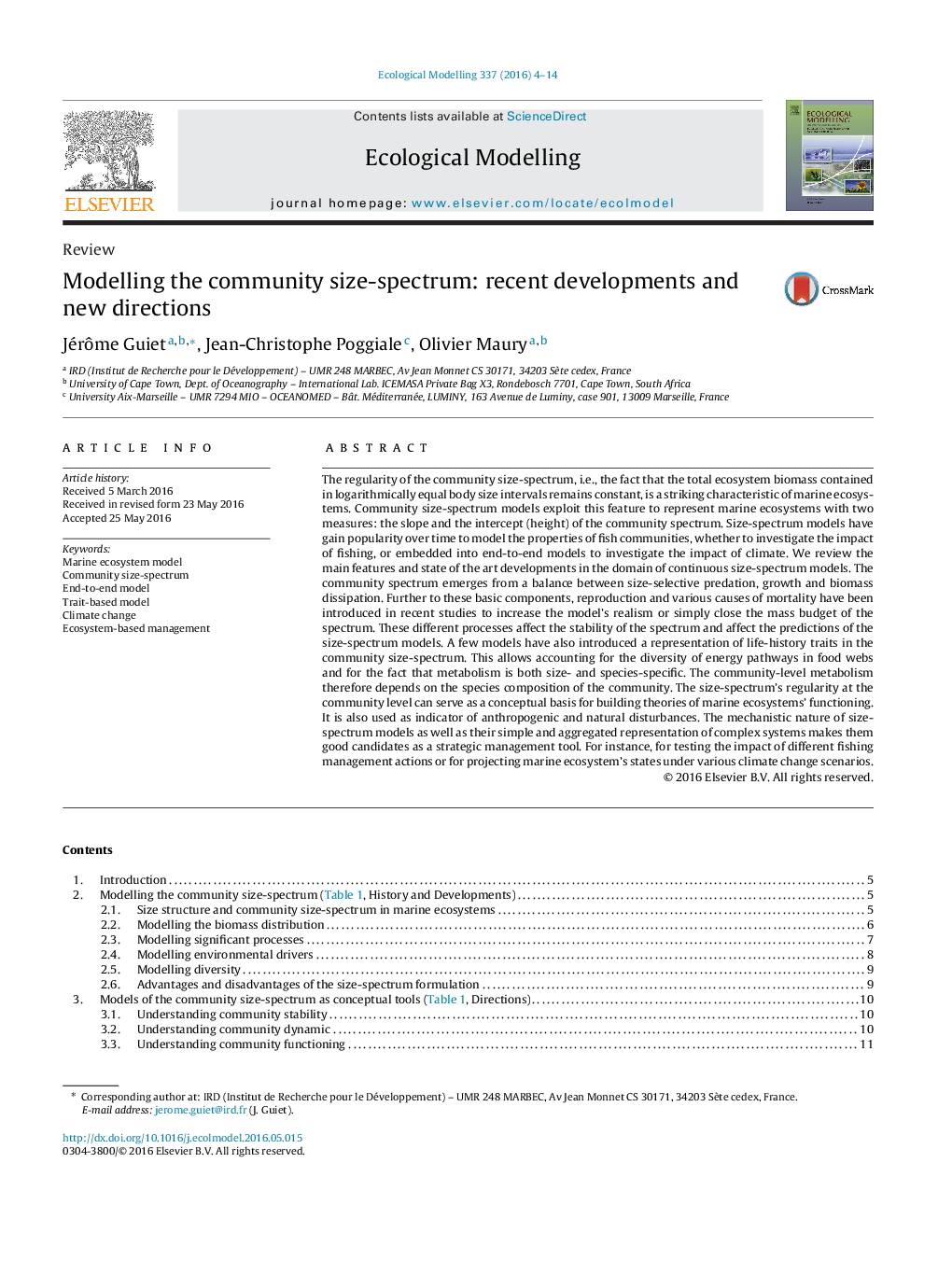| کد مقاله | کد نشریه | سال انتشار | مقاله انگلیسی | نسخه تمام متن |
|---|---|---|---|---|
| 6296043 | 1617410 | 2016 | 11 صفحه PDF | دانلود رایگان |
عنوان انگلیسی مقاله ISI
Modelling the community size-spectrum: recent developments and new directions
ترجمه فارسی عنوان
مدل سازی طیف وسیعی از جامعه: تحولات اخیر و مسیرهای جدید
دانلود مقاله + سفارش ترجمه
دانلود مقاله ISI انگلیسی
رایگان برای ایرانیان
کلمات کلیدی
مدل اکوسیستم دریایی، اندازه جامعه طیف، مدل پایانی به پایان، مدل مبتنی بر ویژگی، تغییر آب و هوا، مدیریت مبتنی بر اکوسیستم،
ترجمه چکیده
منظم بودن حجم اندازه جامعه، یعنی اینکه مجموع زیست توده اکوسیستم موجود در فواصل اندازه گیری شده برابر با لگاریتمی برابر ثابت باقی می ماند، یکی از ویژگی های قابل توجه اکوسیستم های دریایی است. مدل های طیف وسیعی از جامعه از این ویژگی برای نشان دادن اکوسیستم های دریایی با دو روش استفاده می کنند: شیب و رهگیری (ارتفاع) طیف جامعه. مدل های طیف گسترده ای در طول زمان به محبوبیت می رسند تا خواص جوامع ماهی را مدل کنند، چه اینکه بررسی تأثیر ماهیگیری، یا در مدل های پایان به انتها برای بررسی تاثیر آب و هوا، تعبیه شوند. ما ویژگی های اصلی و پیشرفت های هنری در حوزه مدل های طیف گسترده ای را بررسی می کنیم. طیف اجتماعی از توازن بین شیوع انتخابی اندازه، رشد و توزیع زیست توده ظاهر می شود. علاوه بر این اجزای اساسی، تولید مثل و علل مختلف مرگ و میر در مطالعات اخیر به منظور افزایش واقع گرایی مدل و یا صرفه جویی در بودجه جرم طیف به کار رفته است. این فرآیندهای مختلف بر پایداری طیف تاثیر می گذارد و پیش بینی مدل های طیف اندازه را تحت تاثیر قرار می دهد. چند مدل همچنین معرفی نمایه های ویژگی های تاریخ زندگی در اندازه های مختلف جامعه را ارائه می دهند. این اجازه می دهد تا حسابداری تنوع مسیرهای انرژی در شبکه های غذایی و همچنین این که متابولیسم هر دو اندازه و گونه خاص است. بنابراین متابولیسم در سطح جامعه بستگی به ترکیب گونه های جامعه دارد. منظم بودن اندازه طیف در سطح جامعه می تواند به عنوان یک مبنای مفهومی برای ساخت نظریه های عملکرد اکوسیستم های دریایی خدمت کند. همچنین به عنوان شاخصی از اختلالات انسان شناسی و طبیعی استفاده می شود. ماهیت مکانیکی مدلهای طیف گسترده و همچنین نمایش ساده و جمعآوری آنها از سیستمهای پیچیده، آنها را به عنوان یک ابزار مدیریت استراتژیک مناسب می داند. به عنوان مثال، برای آزمایش اثرات اقدامات مدیریت ماهیگیری مختلف و یا برای طراحی کشورهای عضو اکوسیستم دریایی تحت سناریوهای مختلف تغییر آب و هوا.
موضوعات مرتبط
علوم زیستی و بیوفناوری
علوم کشاورزی و بیولوژیک
بوم شناسی، تکامل، رفتار و سامانه شناسی
چکیده انگلیسی
The regularity of the community size-spectrum, i.e., the fact that the total ecosystem biomass contained in logarithmically equal body size intervals remains constant, is a striking characteristic of marine ecosystems. Community size-spectrum models exploit this feature to represent marine ecosystems with two measures: the slope and the intercept (height) of the community spectrum. Size-spectrum models have gain popularity over time to model the properties of fish communities, whether to investigate the impact of fishing, or embedded into end-to-end models to investigate the impact of climate. We review the main features and state of the art developments in the domain of continuous size-spectrum models. The community spectrum emerges from a balance between size-selective predation, growth and biomass dissipation. Further to these basic components, reproduction and various causes of mortality have been introduced in recent studies to increase the model's realism or simply close the mass budget of the spectrum. These different processes affect the stability of the spectrum and affect the predictions of the size-spectrum models. A few models have also introduced a representation of life-history traits in the community size-spectrum. This allows accounting for the diversity of energy pathways in food webs and for the fact that metabolism is both size- and species-specific. The community-level metabolism therefore depends on the species composition of the community. The size-spectrum's regularity at the community level can serve as a conceptual basis for building theories of marine ecosystems' functioning. It is also used as indicator of anthropogenic and natural disturbances. The mechanistic nature of size-spectrum models as well as their simple and aggregated representation of complex systems makes them good candidates as a strategic management tool. For instance, for testing the impact of different fishing management actions or for projecting marine ecosystem's states under various climate change scenarios.
ناشر
Database: Elsevier - ScienceDirect (ساینس دایرکت)
Journal: Ecological Modelling - Volume 337, 10 October 2016, Pages 4-14
Journal: Ecological Modelling - Volume 337, 10 October 2016, Pages 4-14
نویسندگان
Jérôme Guiet, Jean-Christophe Poggiale, Olivier Maury,
